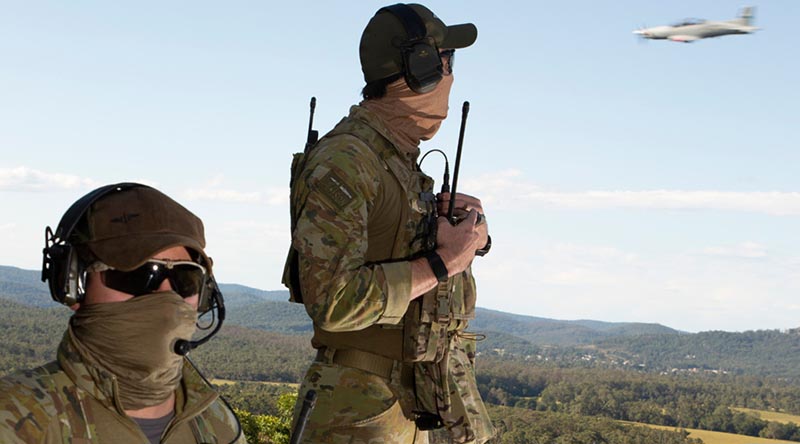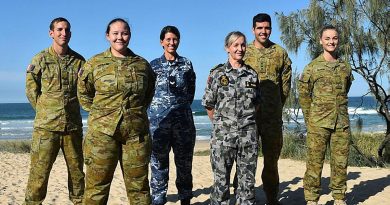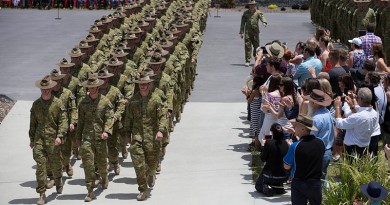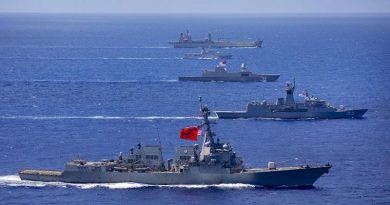Combat controllers causing havoc on the range
Share the post "Combat controllers causing havoc on the range"

Combat controllers from No. 4 Squadron have completed a successful four weeks of close air support (CAS) serials around RAAF Base Williamtown, near Newcastle, NSW, during Exercise Havoc Strike.
CAPTION: Combat Controllers from No. 4 Squadron based at RAAF Base Williamtown communicate coordinates for an incoming aircraft during Exercise Havoc Strike. Photo by Sergeant Brett Sherriff. Story by Flight Lieutenant Alyssa Vickridge.
Internal to the exercise was the completion of the first module of the combat control category upgrade course, involving four experienced controllers drawn from operational teams.
Sergeant Scott, one of the students during Havoc Strike, said the exercise allowed the capability to simulate scenarios and problem sets that required the combat controllers to integrate, synchronise and control multi-domain assets and effects to achieve the commander’s intent.
“Traditionally, training has focused on the same outputs as any ADF joint terminal attack controllers [JTAC], which is a focus on kinetic strike,” Sergeant Scott said.
“On Havoc Strike the participants were introduced to a more demanding operating environment, where they were required to advise on fifth-gen capabilities to enable mission planning.
“When executing the plan we tried to integrate these capabilities on the ground under pressure.
“What that can look like is concurrently managing and safely de-conflicting airspace for multiple fixed and rotary-wing assets, generating an effect on the signals spectrum to disrupt a target, coordinating intelligence, surveillance and reconnaissance [ISR] assets and providing precision strike in close proximity to friendly forces.
“A wider breadth of air power knowledge is one of the things that separate a combat controller from a JTAC,” he said.
While completely at home participating in physically demanding environments, the controllers found themselves operating at a slightly slower pace when they headed to the classroom to cover an in-depth analysis on current regional threat systems and briefings on RAAF and allied platforms and capabilities.
Sergeant Scott said the educational component of the exercise was what ensured success on the ground for the participants.
“Our senior controllers use their first-hand experience to mentor us through real world air/land integration problems with current threat and friendly capability information.
“We were then evaluated on our ability to use this information to problem solve, plan and execute the mission,” he said.
“Havoc Strike is a unique exercise as it is custom built by the squadron around the needs of the participants.
“This means we are able to adjust the training program as required.
“It’s also supported by the 4 Squadron PC-21s piloted by forward air controller-airborne (FAC(A)) certified pilots.
“The exercise provided the first opportunity to work with the 4 Squadron PC-21 aircraft, which were first introduced to 4 Squadron in late January 2020.
“4 Squadron aircrew have been developing and refining CAS standard operating procedures to provide CAS training to ADF JTAC’s.
“Furthermore, the experience gained during Havoc Strike allowed the 4 Squadron aircrew to re-commence FAC(A) training, which had not been able to occur since the withdrawal of the PC-9 in October last year.
“Being part of the same squadron, these guys are intimately familiar with our training goals and are some of the most experienced pilots in RAAF.
“Their participation and contribution is invaluable to the growth of combat control.”
Sergeant Scott said the development of the entire Havoc series of training exercises had come from the successful collation of 13 years’ of warlike operational experience.
“4 Squadron has had members serving in the Middle East from the inception of the capability in 2008 to the current day.”
The next phase of the combat-control training continuum will begin in July with Exercise Havoc Drop.
.
.
.
.
.
.

.
.
Share the post "Combat controllers causing havoc on the range"





